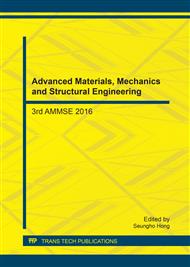[1]
ICC, International Building Code, International Code Council, Whittier, CA, (2012).
Google Scholar
[2]
FEMA, NEHRP Guidelines for the Seismic Rehabilitation of Buildings, Report No. 273, Federal Emergency Management Agency, Washington, D.C., (1997).
Google Scholar
[3]
B. Ellingwood, Earthquake risk assessment of building structures, Reliab. Eng. Syst. Safe. 74 (2001) 251-262.
Google Scholar
[4]
A. Ghobarah, Performance-based design in earthquake engineering: state of development, Eng. Struct. 23 (2001) 878–884.
DOI: 10.1016/s0141-0296(01)00036-0
Google Scholar
[5]
Y. K. Wen, Reliability and performance-based design, Struct. Safe. 23 (2001) 407-428.
Google Scholar
[6]
J. W. Hu, Investigation on the Cyclic Response of Superelastic Shape Memory Alloy (SMA) Slit Damper Devices Simulated by Quasi-Static Finite Element (FE) Analyses. Mater. 7 (2014) 1122-1141.
DOI: 10.3390/ma7021122
Google Scholar
[7]
C. A. Goulet, C. B. Haselton, J. Mitrani-Reiser, J. L. Beck, G. G. Deierlein, J. P. Stewart, Evaluation of the seismic performance of a code-conforming reinforced- concrete frame building-from seismic hazard to collapse safety and economic losses, Earthquake Eng. Struct. Dyn. 36 (2007).
DOI: 10.1002/eqe.694
Google Scholar
[8]
M. R. Kaloop, J. W. Hu, Y. Bigdeli, Identification of the Response of a Controlled Building Structure Subjected to Seismic Load by Using Nonlinear System Models. Appl. Sci. 6 (2016) 301.
DOI: 10.3390/app6100301
Google Scholar
[9]
B. Ellingwood, K. Kinali, Quantifying and communicating uncertainty in seismic risk assessment, Struct. Safe. 31 (2009) 179-187.
DOI: 10.1016/j.strusafe.2008.06.001
Google Scholar
[10]
C. H. Yeh, C. H. Loh, K. C. Tsai, Overview of Taiwan earthquake loss estimation system, Nat. Hazards. 37 (2006) 23-37.
DOI: 10.1007/s11069-005-4654-z
Google Scholar
[11]
FEMA, NEHRP Recommended Provisions for Seismic Regulations for New Buildings and Other Structures, part 2: Commentary, Report No. 303, Federal Emergency Management Agency, Washington, D.C., (1997).
Google Scholar
[12]
J. H. Lin, Seismic performance evaluation of buildings in Taiwan, Appl. Mech. Mater. 638-640 (2014) 1854-1857.
DOI: 10.4028/www.scientific.net/amm.638-640.1854
Google Scholar
[13]
J. H. Lin, Exceedance probability of extensive damage limit for general buildings in Taiwan, Disaster Prev. Manag. 12 (2012) 451-463.
DOI: 10.1108/09653561211234543
Google Scholar
[14]
W. I. Liao, C. H. Loh, K. C. Tsai, Study on the fragility of buildings structures in Taiwan, Nat. Hazards 37 (2006) 55-69.
DOI: 10.1007/s11069-005-4656-x
Google Scholar


